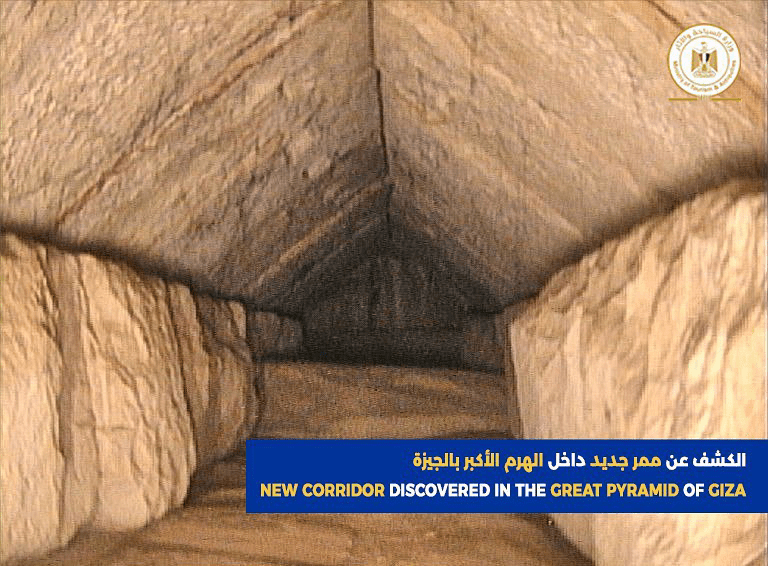A hidden corridor inside the Great Pyramid of Giza has been seen for the first time since it was sealed some 4,500 years ago.
In 2017, a team known as ScanPyramids scanned the Great Pyramid of Giza using muon tomography. Looking inside the pyramid, the team found what tomb raiders through the centuries apparently hadn’t: a hidden chamber located above the King’s Chamber.
They named the big void, rather aptly, the “big void”, and it was confirmed using three different muon detection techniques. Of course, a big mysterious void inside the largest pyramid was not going to remain unexplored for long, and now officials at the Egyptian ministry of antiquities have confirmed its existence with an endoscope camera.
“When inserting a camera through one of the openings underneath the entrance, this scan revealed the existence of a corridor 9 meters [30 feet] long and 2.10 meters [6.9 feet] wide with a chevron ceiling,” Mostafa Al-Waziri, from Egypt’s Supreme Council of Antiquities, said in a press conference. “Most likely this corridor was built to relieve the weight of the pyramid.”
The corridor, seen for the first time in thousands of years. Image credit: Egypt Ministry of Tourism and Antiquities.
The corridor has been the subject of a recent paper from scientists at the University of Paris-Saclay in France and Nagoya University in Japan, who used cosmic-ray muon radiography to scan the void once more.
“Khufu’s Pyramid is the first pyramid, in the history, that uses a Chevron technique to cover internal structures and prevent them from collapsing,” the team wrote in the paper published in Nature Communications.
“We can find Chevron on the North Face, in the queen’s chamber ceiling and above the king’s chamber. The construction process of the oldest of the seven wonders of the ancient world is one of the most important archaeological mysteries.”
“Any discovery of previously unknown internal structures could contribute to the knowledge on the construction of this Pyramid.”
This video shows the inside of the corridor (skip to 21 seconds to see the footage).
The purpose of the corridor and the larger void it leads to remains unknown.
One theory, as mentioned at the press conference showing the inside of the corridor, is that it was there to relieve pressure inside the pyramid. Another is that the void could be a result of how the pyramid was constructed, an internal ramp used to move roof blocks into position, which was then left or filled loosely with rubble.
Another slightly more exciting theory is that the corridor leads to a secret burial chamber of Khufu. When the pyramids were first opened and explored, 19th-century archaeologists found a number of chambers, including one containing a sarcophagus that was thought to contain Khufu himself. However, when the sarcophagus was opened, it was empty.
The remains have long been, and continue to be, presumed to be stolen. However, according to two amateur French Egyptologists, there could be another burial chamber as yet undiscovered that contains Khufu’s remains. According to their theory, the pyramids were built a lot more haphazardly than we thought, with plans adjusted as the work went on as the builders realized certain chambers would not take the weight of a sarcophagus.
“At the end of the day,” Gilles Dormion, the architect of the pair, said of the theory in 2004, “the entire problem of the Great Pyramid can be summed up by this theory: Khufu had three funeral chambers built for himself. The first remained unfinished, the second was available and the third cracked. Khufu was therefore interred in the second.”
Though it’s probably best not to get your hopes up for finding King Khufu, Egyptian archaeologist Zahi Hawass told the BBC that the corridor may lead to “something important” which could include the burial chamber of Khufu, adding, “I’m sure in a few months from now we can see if what I’m saying is correct or not.”
Source Link: The Hidden Corridor Inside The Great Pyramid Of Giza Has Been Photographed For The First Time
